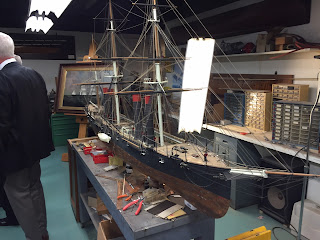29 December 2015: I said I wouldn't bother you all again until after Christmas - and it is well after Christmas now. I hope each of you enjoyed a wonderful Christmas with family, friends and fun! So on to today's important subject: USS Constitution vs HMS Java on this date in the first year of the War of 1812.
 |
| USS Constitution on her 200th birthday |
It was Constitution's 2nd victory (first was in August against HMS Guerriere when she won the sobriquet "Old Ironsides" and brought joy to the people of the United States after a string of devastating defeats) and caused the Admiralty of the Royal Navy to change its policy regarding American heavy frigates.
The ship had left Boston in early August of 1812, William Bainbridge commanding. She headed south, in company with USS Peacock, James Lawrence (Yes, the "don't give up the ship" James Lawrence) and cruised off the coast of Brazil looking for targets of opportunity. On the morning of 29 December, a strange sail was sighted and Captain Bainbridge went to investigate. It proved to be HMS Java, a Royal Navy frigate similar to Guerriere. Both captains determined to engage.
A savage battle - and Constitution's most devastating - ensued. In the second salvo from the enemy, she lost her wheel - completely - and Bainbridge was forced to rig jury steering at the rudder head below and shout his orders to a crew hauling on tackles to turn the ship. Java tried unsuccessfully to rake (fire a full broadside down the length of the other ship., either from astern or from forward) and then the two ships fouled, Java's bowsprit caught in Constitution's mizzen rigging. Bainbridge cleared the foul by shooting away his enemy's bowsprit.
The battle raged on, each captain seeking an advantage, firing devastating broadsides, and trying to avoid the enemy's fire.
 Three hours later, and after a thorough and horrendously devastating battle, Java struck her flag, but was so badly damaged that Bainbridge had no choice but to burn her to the waterline and sink her. Naturally, he removed the wounded and healthy from the ship before destroying her. Java lost nearly a third of her crew, while Constitution hardly escaped unscathed: ten killed outright, forty-six wounded (four later died of their wounds) and five officers also wounded, including Bainbridge. The ship suffered her worst damage of the war, losing her fore and mizzen masts, her main topmast, both main tops'l yards, spanker boom, gaff, and trysail mast. Additionally, her standing rigging was severely damaged, requiring substantial time to repair.
Three hours later, and after a thorough and horrendously devastating battle, Java struck her flag, but was so badly damaged that Bainbridge had no choice but to burn her to the waterline and sink her. Naturally, he removed the wounded and healthy from the ship before destroying her. Java lost nearly a third of her crew, while Constitution hardly escaped unscathed: ten killed outright, forty-six wounded (four later died of their wounds) and five officers also wounded, including Bainbridge. The ship suffered her worst damage of the war, losing her fore and mizzen masts, her main topmast, both main tops'l yards, spanker boom, gaff, and trysail mast. Additionally, her standing rigging was severely damaged, requiring substantial time to repair.
But Bainbridge sailed her home to accolades and honors, and a lengthy refit in Boston. The ship would not escape to sea again for some time, but did manage it before the war ended in early 1815.
Fair Winds,
Old Salt



































